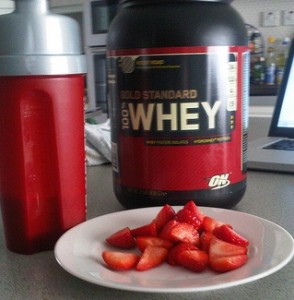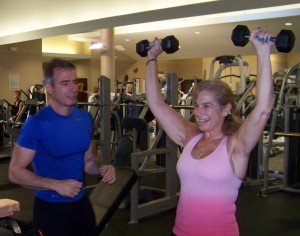by Michelle Sutton-Kerchner
Are you sabotaging your workout with these bad habits? Get the most from your exercise routine. Tweak it right now …
Avoid the Express Route
In an effort to get to business, some hit the floor running, cycling, or lifting. Others mistakenly perform a session of deep stretches as a segue. Since our school gym days, we were taught to stretch before exercising. However, stretches are best done on warmed muscles. Otherwise, the act of stretching can cause muscle pulls and strains. Instead, perform five to 10 minutes of cardio exercises, such as running in place or jumping rope. Once your body feels warm, gradually stretch each muscle group.

Keep the body in motion while stretching so you continue to warm-up slowly. Don’t attempt to deepen the stretch. Try neck tilts, and arm and leg swings. Exercise professional Jillian Michaels recommends butt kicks while walking or lightly jogging. Exaggerate the leg’s motion so your heel kicks you in the buttocks, with knee pointing to the ground. Keep the entire body moving, including arms pumping as you would while walking.
If you just finished a game of volleyball, a sauna session, or soak in the spa tub, you have permission to go directly to gentle stretches. A pre-workout hot shower also helps warm up and loosen muscles, as does a heating pad on sore spots.
After your exercise routine, stretch away. You’ll be amazed at how limber a good workout makes you. Suddenly, the distance from fingers to floor seems so much less.
Fuel Your Fitness Efforts
It is not necessary to eat before exercise. Instead, drink eight ounces of clear fluid within 30 minutes pre- and post-exercise. Avoid working out when hungry though, or if haven’t eaten in over two hours.
Satisfy hunger at least 30 minutes to an hour prior to exercising. Choose snacks that combine carbohydrates and protein, with emphasis on carbs. Enjoy a small treat, such as a half bagel or large banana. A couple tablespoons of peanut butter or a cup of yogurt deliver the protein needed to preserve muscle and increase energy. Avoid high-fat or high-fiber snacks, which may upset stomach and decrease energy.
An intense sweat session does not permit a post-workout binge on junk. The food choices you make greatly affect the results of your fitness routine. Within 30 minutes of exercise, try to consume a high-protein snack or small meal. Research shows combining that protein with carbohydrates can result in a beneficial increase of stored glycogen. Aim for a 4:1 ratio with four grams of carbs for every one gram of protein.

Protein helps rebuild muscle tissue that may be weakened after intense, prolonged exercise. It improves muscle hydration. The amino acids in protein also stimulate the immune system, making you more resistant to colds and other infections. Consider consuming this carb/protein combo via a sports drink to assure the right ratio in the 30-minute post-workout timeframe.
Post-workout protein picks:
- Hardboiled egg
- A handful of almonds, walnuts, or pistachios
- Yogurt (Go Greek: 15 to 20 grams of protein in a 6-ounce serving of Greek yogurt versus 9 grams in regular)
- Protein smoothies (Add whey protein, which contains essential amino acids needed to build and maintain muscle.)
- Cottage cheese
- Natural peanut butter on celery
Avoid “rewarding” yourself with an ice cream sundae. This little splurge probably costs more calories than you burned. Instead, reinforce your efforts with a power-building snack.
Don’t Overdo It

Attack your workout with all you have. Then, go no farther. Pushing yourself beyond what feels “right” can derail your training in multiple ways. Not only will weight loss elude you while recovering, you may even gain weight laid up on the couch. Training for peak performance can backtrack to simply training to function. Motivation drops as you spiral downward. And, you think, “But I tried so hard!” Hard is right.
Overexerting yourself is not the recommended slow-and-steady approach to reaching fitness goals (or any aspirations). Walk before you run, or you may end up crawling.
If you do fall victim to an overzealous approach, recognize it and adjust. Check with a personal trainer who can offer you a gradual way to advance your routine. S/he can also modify your workout to accommodate any strains and prevent further injury. A pulled neck does not excuse a vigorous lower-body workout; you can still get a cardio workout in the pool with shin splints.
Follow proper form and your limits. Sometimes “no pain” really does equate to a beneficial gain.
Be Challenged
Exercisers often report the inability to engage to their fullest extent. What may be considered enough to do the job, in reality, may not be. Take advantage of your membership. Seek the advice of Center nurses, personal trainers, and Group Fitness instructors. Determine your target heart rate and what it takes to get– and keep– you there for the required amount of time.
A healthy individual without medical restrictions should accomplish a high-intensity workout for best results. Go for a routine that elevates your heart rate to 85 percent of your maximum. Calculate your maximum heart rate in beats per minute: Men should subtract age from 226. A new formula for women was recently devised. It is slightly more complicated but confidently more accurate: 206 minus 88 percent of a woman’s age.

A trainer, with professional insight, often better gauges how far we can go. Insecurities or past injuries make it difficult to realize true potential. With a keen eye to form, and simply knowing the point at which most muscles have had enough, trainers are said to better know a member’s limits. One member commented, “My trainer never allows me to exercise half-way. He pushes me and I appreciated every minute of it.” Sometimes, we surprise ourselves at how far we can go. Often, we’re made of stronger stuff than we think.
Use a Spotter
When using heavy weights, spotting is required. However, light weights deserve the same respect. Monitor yourself in the mirror throughout each movement, both during the lift and let-down motions. Ask another to observe, especially if you are a newbie and don’t yet recognize improper form.
Ask the Group Fitness class instructor to spot check you. Bad form happens beyond the Exercise Floor. Typically, a move learned in fitness class or on the Exercise Floor is repeated in some modified form at various other points in your routine. A slight shift in where your body weight rests during each movement, every time, can be the difference between a bikini or oversized T-shirt this beach season.
Awareness is how bad habits are avoided or broken.
Undoing the Habit
Unlearning, relearning, quitting a negative, starting a positive. Experts say it takes about four to six weeks to succeed with a habit. Within that time, the brain starts to adapt to the new behavior and perform it on autopilot. Until then, and even beyond, a conscious effort must be made.
Try incorporating a trigger during your workout. It can be something private that you silently shout to yourself, or you can request a fitness trainer or instructor to alert you. For example, if locked knees are hindering your form, have your Group Fitness instructor bring it to your attention by alerting at appropriate times, “Knees!” Or, snap your fingers to bring awareness to the misstep on your own. Snap each time it’s an issue as a continuous reminder. Stick with this rep, class routine, or movement until it’s corrected for good. Consistency is the key to success.
It is usually best to fix one bad habit at a time. However, when safety is a concern, every effort should be made to simultaneously implement your new strategies. Don’t skip your warm-up because this month you’re focusing on recognizing your limits.
The success of a happy, productive workout relies on each move that defines it. It also encompasses pre- and post-fitness activities. It ripples to your entire day, week, year, life. Move mindfully.
Sources
“6 Bad Fitness Habits You Should Break,” at www.jillianmichaels.com.
“Eating after Exercise: What to Eat after a Workout,” by Elizabeth Quinn at www.about.com.
“Recalibrated Formula Eases Women’s Workouts,” by Tara Parker-Pope at www.nytimes.com.
Image Credits
Habit sign (introductory photo): www.davincidilemma.com
Stretch: By Simon Glucas at http://www.flickr.com/photos/simonglucas/5211842546/
Protein shake: http://www.flickr.com/photos/tomoswyn/5812447532/
Weightlifter: http://www.flickr.com/photos/jontunnell/4417905070/
 Fitness & Wellness News Your Source for Fitness News, Wellness News, Health News, and Nutrition News!
Fitness & Wellness News Your Source for Fitness News, Wellness News, Health News, and Nutrition News!



